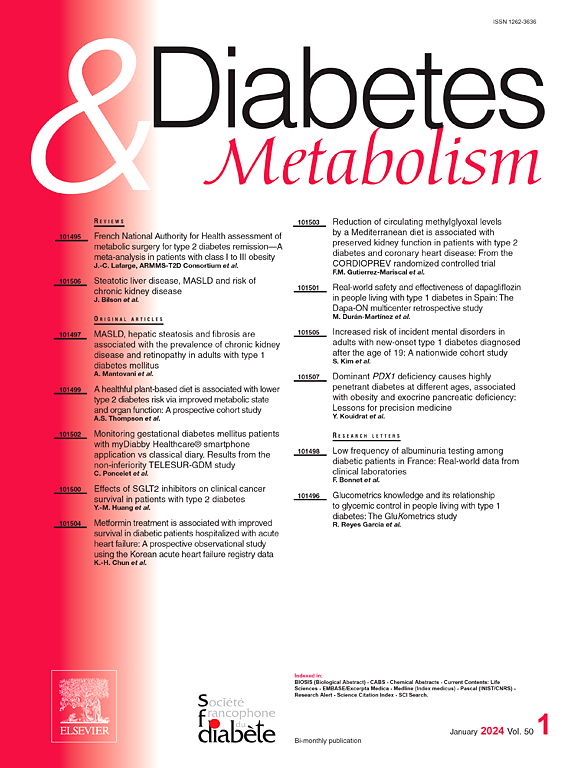糖尿病学家需要了解的关于非动脉性前缺血性视神经病变的风险和GLP-1受体激动剂在2型糖尿病患者中的应用
IF 4.7
2区 医学
Q1 ENDOCRINOLOGY & METABOLISM
引用次数: 0
摘要
目的:最近的研究结果引起了人们对使用西马鲁肽与非动脉性前缺血性视神经病变(NAION)之间的潜在关联的关注,NAION是一种罕见的永久性视力丧失。本报告对GLP-1受体激动剂(RA)在2型糖尿病(T2D)患者中的使用和NAION风险的当前知识进行了批判性分析。方法:采用文献检索策略,对截至2025年4月的所有英文文献进行系统综述。结果:在包括T2D患者的研究中,与使用GLP-1 RA(主要是西马鲁肽)相关的NAION风险的相对增加从不显著到四倍不等,而受影响患者的绝对数量仍然很低。考虑到主要研究的回顾性设计,GLP-1RAs的使用与NAION之间没有因果关系。有人提出了一些机械性的假设,但迄今为止还没有得到正式证明。GLP-1RAs诱导的深刻的代谢和血流动力学变化可能是易患视神经“危险盘”的患者发生NAION的触发因素,这是一个很容易通过眼部检查发现的强大的解剖学危险因素。结论:有待研究澄清这一风险,这些发现呼吁谨慎使用GLP-1 RAs,特别是在有眼部危险因素的患者中。鉴于GLP-1RAs的广泛使用,临床医生应该意识到这种潜在的风险,而不是掩盖GLP-1RAs在2型糖尿病患者中的显着益处。本文章由计算机程序翻译,如有差异,请以英文原文为准。
What the diabetologist needs to know about the risk of non-arteritic anterior ischaemic optic neuropathy and GLP-1 receptor agonist use in patients with type 2 diabetes
Aim
Recent findings have raised concern about a potential association between semaglutide use and non-arteritic anterior ischaemic optic neuropathy (NAION), a rare form of permanent vision loss. This report provides a critical analysis of the current knowledge of GLP-1 receptor agonist (RA) use and risk of NAION in patients with type 2 diabetes (T2D).
Methods
A literature search strategy was conducted for all English-language literature with a systematic review of key references up to April 2025.
Results
Across studies including patients with T2D, the relative increase in NAION risk associated with the use of a GLP-1 RA, mainly semaglutide, ranged from nonsignificant to fourfold, while the absolute number of affected patients remained low. Given the retrospective design of the main studies, no causal link could be established between the use of GLP-1RAs and NAION. Some mechanistic hypotheses have been put forward without any being formally demonstrated to date. The profound metabolic and haemodynamic changes induced by GLP-1RAs might be the trigger of NAION in predisposed patients with an optic “disc-at-risk”, a potent anatomical risk factor easily detected by ocular examination.
Conclusion
Pending studies clarifying this risk, these findings call for cautious use of GLP-1 RAs, particularly in patients with ocular risk factors. Given the widespread use of GLP-1RAs, clinicians should be aware of this potential risk, without overshadowing the remarkable benefit of GLP-1RAs in patients with type 2 diabetes.
求助全文
通过发布文献求助,成功后即可免费获取论文全文。
去求助
来源期刊

Diabetes & metabolism
医学-内分泌学与代谢
CiteScore
12.00
自引率
4.20%
发文量
86
审稿时长
13 days
期刊介绍:
A high quality scientific journal with an international readership
Official publication of the SFD, Diabetes & Metabolism, publishes high-quality papers by leading teams, forming a close link between hospital and research units. Diabetes & Metabolism is published in English language and is indexed in all major databases with its impact factor constantly progressing.
Diabetes & Metabolism contains original articles, short reports and comprehensive reviews.
 求助内容:
求助内容: 应助结果提醒方式:
应助结果提醒方式:


